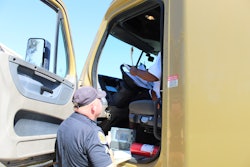As advanced as new trucks have become, some of the pieces remain fairly basic and largely untouched by modernization. In the early 1900s, mirrors were an option, and it wasn’t until the 1970s that passenger side mirrors became standard. About a decade later, they became powered, but in the 40 years since, there hasn’t been a lot of energy put into innovation. Until recently.
Enacted in 2014, Greenhouse Gas (GHG) Phase 1 dictated that trucks, by model year 2017, achieve a 7%-20% reduction in carbon dioxide (CO2) emissions over MY 2010 baselines. Now, GHG Phase 2 calls for, by MY 2021, a 15%-25% reduction over 2017. To-date, engine manufacturers have done most of the heavy lifting to boost efficiency, but much of that low-hanging fruit has been picked, making aerodynamics and drag coefficients more important than ever.
Mirrors are responsible for approximately 2% of the aerodynamic drag created by a tractor, but federal regulations that require “two rear-vision mirrors, one at each side, firmly attached to the outside of the motor vehicle” haven’t left a lot of room for breakthroughs. That regulation did, however, leave Novi, Mich.-based Stoneridge – a designer and manufacturer of engineered electronic systems for safety and security, vehicle intelligence efficiency and emissions – enough room for interpretation.
A leap forward in looking backward
Stoneridge’s MirrorEye Camera Monitor System replaces a truck’s conventional mirrors with integrated external digital cameras mounted outside above the cab and digital monitors inside. The MirrorEye system includes five cameras, sensors and three high-definition digital display screens.
The camera housing’s design helps keep it clean by creating a vacuum at the lens. In the off-chance that rain or mud splashes onto the lens, the vortex created by aerodynamics helps remove it. Heavy soiling can be removed with a towel or a blast of water. The lens is heated to prevent icing.
Independent video processing of multiple camera images offers a form of redundancy by ensuring that in the unlikely event an individual camera fails, the other real-time camera images will be displayed continuously without interruption.










